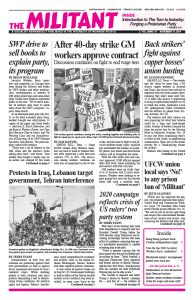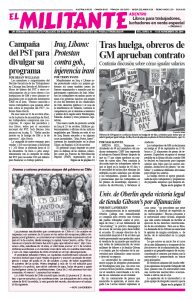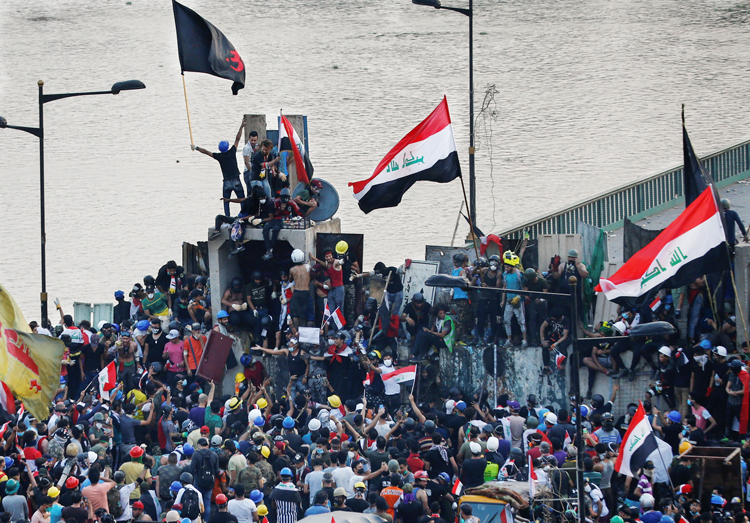Demonstrators in both Iraq and Lebanon are protesting against their own governments as well as against forces organized and armed by Iran’s capitalist rulers. While working people in both countries join mass protests demanding a halt to deteriorating living conditions, for political rights and against Tehran’s interference, sharp competition for economic and military sway in the region between Washington, Tehran, Ankara and other capitalist powers continues.
A new round of protests broke out in Iraq Oct. 25. Government buildings as well as offices of the Tehran-backed militias across southern Iraq were attacked, in some cases burnt to the ground. “Iran get out, get out,” demonstrators in Tahrir Square, Baghdad, chanted Oct. 26.
The Iraqi government is partly dependent for its defense on militias, known as Popular Mobilization Forces, organized among Shiite Iraqis by Tehran’s Revolutionary Guard.
Despite mounting casualties the numbers joining the anti-government protests has broadened. In defiance of the education minister, school students walked out of classes Oct. 28. The teachers’ union announced a four-day strike that day, demanding the government resign.
Tehran seeks to extend reach
The bourgeois clerical regime in Iran has relentlessly fought to extend its counterrevolutionary reach throughout the Mideast, using proxy fighters like the Popular Mobilization Forces in Iraq, as well as Hezbollah in Lebanon and Syria and Houthi rebel forces in Yemen.
The Israeli rulers launched airstrikes on PMF bases in Iraq this summer seeking to prevent Tehran from transferring weapons to allied militias in Syria where they are used to target Israeli civilians. Hezbollah’s leaders boast they have missiles in place that can hit every square inch of Israel.
The Iranian rulers’ interventions across the Mideast are falsely presented by both Washington and the capitalist rulers in Iran as the result of the 1979 Iranian Revolution.
In fact the moves of Iran’s bourgeois clerical rulers both at home and abroad are the outcome of a counterrevolution they carried out, taking years to turn back significant gains by workers, farmers, women and oppressed nationalities won with their revolution.
Millions had mobilized to overthrow the brutal rule of the U.S.-backed shah. They organized to use that victory to win new political and social rights. Workers set up workers councils in the oil fields, auto plants and other workplaces to fight for their class interests.
“In Iran today, faced with rising unrest among working people and the oppressed, the only way for the capitalist rulers to defend and preserve their counterrevolutionary regime at home is to continue extending political reaction throughout Iraq, Syria, Lebanon, Yemen and divided Kurdistan,” Socialist Workers Party leader Steve Clark explains in Revolution, Counterrevolution and War in Iran, a Militant supplement published last April. It is available on the Militant’s website.
‘End sectarian political system’
Working people in Lebanon are demanding the fall of the governing coalition, where posts are allocated on religious lines. The prime minister has to be a Sunni Muslim, the speaker a Shiite Muslim and the president a Maronite Christian. Strict quotas determine appointments in the army and other state institutions. Hezbollah, which claims to represent all Shiites in Lebanon, plays a crucial role in the government. Hezbollah head Hassan Nasrallah has fought to quell the protests, but instead they have spread into Shiite areas that the Tehran-backed outfit controls.
State security forces stood aside as Hezbollah thugs set fire to and broke up an encampment protesters had set up in central Beirut.
Initially organized to protest tax hikes on gas, tobacco and WhatsApp, which many use for communication, demonstrators are increasingly demanding the fall of the government. Acceding to the protests, Prime Minister Saad al-Hariri said Oct. 29 he will hand in his resignation. His cabinet will remain in office until a new government is formed.
“It’s a country where which sect or which political leaders you belong to secures you a job,” Nina Sabbah told Reuters. Sabbah, a Shiite Muslim from Hezbollah-dominated southern Lebanon, joined Sunnis, Christians and Druze to protest the sectarian setup.
“All of them means all of them. Nasrallah is one of them,” has become a popular chant at demonstrations.
Despite threats of attack, some 170,000 protesters of all religions formed a 105-mile human chain Oct. 27 connecting the country’s north and south. The government “kept us caged in their little sects and forced us to hate one another,” Yara Khawam, one of the organizers, told CNN.
U.S. rulers exert power
Despite claims by liberal opponents of the Donald Trump presidency, Washington has no intention of pulling out of the Middle East and giving up U.S. imperialism’s economic and political interests in the region. One example was the Pentagon’s special forces mission to cold-bloodedly assassinate Abu Bakr al-Baghdadi, the central leader of the reactionary Islamic State, near Idlib, Syria, Oct. 26.
Just as Hillary Clinton and Barack Obama took pride in overseeing Washington’s execution of Osama bin Laden in 2011, so Trump contemptuously bragged that al-Baghdadi “died like a dog.” Nine other people were killed in the operation.
Washington has also redeployed troops and armored vehicles from Iraq into the Deir el-Zour region of Syria. Additional military assets were being sent, the Defense Department said, “to prevent the oil fields from falling back into the hands of ISIS [Islamic State] or other destabilizing actors.” Those other “actors,” of course, include the Syrian dictatorship of Bashar al-Assad.
Washington also deploys some 200 special forces in al-Tanf, alongside an allied Syrian rebel commando unit, near one of the main roads from Iraq that connects Tehran to Damascus and Lebanon.


